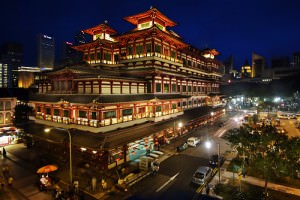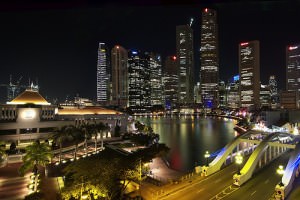Singapore: A Future Economic Powerhouse?
How Singapore blossomed into a world-class economic example
Written by Exequiel Octavio Bertaina, Staff Writer
On 9 August 1965, after enduring two years of intense friction with the Malaysian central government in Kuala Lumpur, Singapore declared its independence to become the Republic of Singapore. Singapore chose to maintain a certain social and cultural distance from its neighbouring countries, while deliberately developing a new and distinctively ‘Singaporean’ culture and social identity. By late 1989, though physically small, Singapore was an economic giant. It is a multicultural, modernized and orderly country, with its major cities populated by a mosaic of individuals hailing from Chinese, Arab, Malaya, Indian and English backgrounds.
Economic Reform
The components that propelled Singapore’s success were comprised of major reforms in every aspect of the country. The central government was aware of the need to develop policies that would enable Singapore to attract investors and business, so it instated policies that would promote international trading and ensure economic development.
Education Reform
In 1979, the educational system was overhauled, with one of the primary goals being to decrease the dropout rate and to help those with low academic performances leave school with some marketable skills. The schools now operate on a modified British-style system in which the main qualifications are equivalent to the Cambridge University General Common Entrance Examination levels. The primary language of instruction in schools is English, while varieties of distinctive dialects (of Chinese, Indian and Malaysian background) hold primacy at home, where traditional practices and language customs are still prominent.
In 1987, Singapore’s school system saw further reform when 4 percent of the gross domestic product (GDP) was devoted to education, but the government’s goal for the 1990’s was to increase spending to 6 percent of their GDP, which would match the levels of Japan and the United States. While education was not obligatory in Singapore, records suggest that attendance is nearly universal. Primary education is free and citizens receive free education until they reached university. There were special funds available to ensure that no student dropped out because of financial need and they even created a system of loans, bursaries and scholarships for superior academic performance.
Industrial Legacy
When Singapore separated from Malaysia, the Singaporean industrial sector was miniscule. In 1960, it was a mere 11.4 percent of the GDP and commerce was by far the largest sector, which accounted for 32 percent of the GDP. In 1959, the country began implementing new policies to promote industrialization. Singapore adopted several new import/export policies, including the 1967 “Proclamation of the Export Expansion Incentives Act” and the 1968 “Employment Act”.
These policies ensured that direct foreign investment was viable, allowing Singapore to become a serious contender on the international market. Throughout the 1970’s various programs were implemented in order to encourage the growing industrial structure and to accelerate the country towards higher skilled, more technology driven and higher valued economic activities.
Technological Development
Back by government encouragement in the 1970’s, Singapore’s technological industry began a calculated transition away from labour-intensive products and towards the development of more technologically advanced production facilities. The National Computer Board was created in 1981 to help establish Singapore as an international center for computer services. In addition, it reduced the shortage of trained computer professionals and assured that high-tech professionals trained in Singapore had skills that were competitive on the international job market.
In order to ensure the continued health of the technological sector, the Singapore parliament passed its first copyright law in 1986, to restrict the manufacturing and selling of black market goods. Laws such as this were important in order to avoid trade sanctions by the western markets. Such measures also ensured that international computer and software companies would continue to do business with companies based in Singapore.
Manufacturing
By 1988, the Singapore manufacturing sector was producing more economic returns than both the financial and business sectors. A large component of the success of the manufacturing sector lies in Singapore’s success endeavour to encourage foreign and international investment in Singapore-based companies. The manufacturing industry was increasingly in the forefront of technological innovation because of the Economic Development Board’s promotion of computer-controlled production, industrial robots and flexible manufacturing systems.
To a lesser degree, domestic enterprises also played a role in the continued industrial growth of Singapore. As the Singapore government believed that an emphasis on large international companies would effectively increase productivity and long-range economic development, major government-sponsored promotional efforts were put into practice, with a focus on higher productivity projects.
The Petroleum Factor
Petroleum and petrochemicals are among Singapore’s main industrial and economic sources of wealth. In the late 1980’s, Singapore was the world’s third largest oil-trading center and as the center for refining petroleum. Additionally, it was the second largest builder of drilling rigs. Their facilities for repairing and maintaining existing rigs and tankers were among the most competitive in Asia. In 1981, when oil prices began to fall, Singapore felt both negative and positive consequences.
 The collapse of oil prices dealt a severe blow to oil exploration. The impact was felt widely and immediately in everything from reduced orders for rig construction to lowered occupancy of luxury apartments as foreign petroleum workers returned home. Their vulnerability was based on their heavy dependence towards outside markets. It lead to the leaders of Singapore in finding a way to buffer their country’s response to perturbations in the world markets and to take advantage of their country’s ability to respond to changing economic conditions.
The collapse of oil prices dealt a severe blow to oil exploration. The impact was felt widely and immediately in everything from reduced orders for rig construction to lowered occupancy of luxury apartments as foreign petroleum workers returned home. Their vulnerability was based on their heavy dependence towards outside markets. It lead to the leaders of Singapore in finding a way to buffer their country’s response to perturbations in the world markets and to take advantage of their country’s ability to respond to changing economic conditions.
Unable to control so much that affected their nation’s prosperity, they concentrated on those domestic institutions that could be controlled. The consequence was an economy characterized by a seemingly paradoxical adherence to free trade and free markets, in combination with a dominant government role in macroeconomic management and government control of major production enterprises.
Some of the additional benefits included the availability of cheaper energy and its refineries invested in equipment and technology necessary to enable them to refine a wide variety of crude oils to obtain a greater proportion of high valued products from the refining process. Petroleum refining alone made up 28 percent of Singapore’s manufacturing output in 1985, although by 1988, it had dropped by half because of a decline in petroleum production and growth in other industries. Singapore also benefited indirectly when large oil importers such as Japan and the United States obtained higher real incomes from lower oil prices, enabling them to increase their imports from Singapore and other countries.
In addition, the extraordinarily high domestic savings rate provided financial reserves, which enabled Singapore to weather economic storms such as trade recessions, and generated a pool of domestically controlled capital to serve the long-term interests of Singapore. However, as the high savings rate was the result of carefully formulated government programs, this included a compulsory contribution of up to 25 percent of all salaries to a government-controlled pension fund.
The government also operated a set of government-owned enterprises and held stock in additional domestic and foreign firms. Government leaders, deeply aware of Singapore’s need to sell its services in a competitive international market, continually stressed the necessity for the citizens to master high levels of skills and to lower their personal wishes for the good of the community. The combination of devotion to free-market principles and the need for internal control and discipline in order to adapt to the demands of markets ensured they would continue to process in the international markets.
Legacy
Developing countries should take notice that it takes time, patience, perseverance and determination to become a more important player in the global markets. Singapore clearly demonstrated this by gradually instating well thought reforms. Another key aspect is government intervention and regulation of the market and production sectors. The government clearly had a long-term objective, but adjusted its policies based on current realities.
During the oil price collapse, the Singapore government quickly realized that they needed to be less vulnerable to market shocks. Therefore, they reacted appropriately by instating reforms aiming towards the high-end manufacturing sector and higher-skilled labour markets. While the political atmosphere in Singapore has been criticised for its laissez faire approach to democracy, its political environment was a primary force in helping to stabilize the economy.
What other countries should also learn from Singapore is that political stability, high level of education, open-market policies, modernized infrastructures, attracting foreign investor policies and sustainable long-term economic objectives are key elements to ensure a country’s success in today’s competitive markets.
Image courtesy of http://www.flickr.com/photos/adforce1/
































Share the post "Singapore: A Future Economic Powerhouse?"